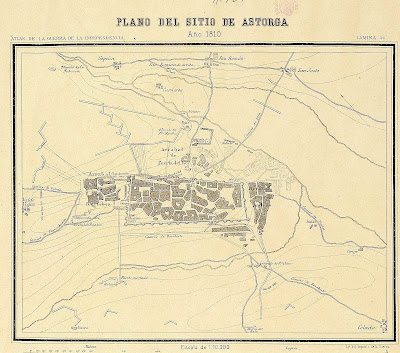The siege of Astorga (march-april 1810)
 The siege of Astorga of 21 March-22 April 1810 was a preliminary operation before the start of Masséna’s invasion of Portugal.
The siege of Astorga of 21 March-22 April 1810 was a preliminary operation before the start of Masséna’s invasion of Portugal.
Astorga was located in the right flank of the French advance and was also a key point for any French campaign in Galicia. The town was built on the south eastern end of a steep hill and surrounded by medieval walls. La Romana (the Spanish general returned from Denmark with British help) repaired the walls and built outworks in a northern suburb on the hill and in northern and eastern suburbs at the base of the hill. At the start of 1810 the town contained a garrison 2,700 strong under the command of the Colonel José Santocildes and around 1,000 civilians.
The task to take Astorga was given to general Junot, Duke of Abrantes, commanding the 8th French Corps (21,000 infantry and 5,000 cavaley). Even lacking a proper siege train, Junot was determined to begin the siege of Astorga without delay, and the town was invested on 21 March.
The French decided to attack the northern corner of the walls, close to the cathedral (significant sections of the wall still survive in this area). For the first three weeks of the siege the French could do very little to damage the walls, but they used the time to build up their gun batteries and siege works in preparation for the arrival of the guns.
Santocildes conducted an active defence, launching a number of sorties against the French trenches, but his only real hope was the arrival of a Galician army. Unfortunately only 5,000 men arrived, a not big enough army to lift the French siege.
The first French siege guns arrived on 15 April. Despite only consisting of four 24-pounders, one 16-pounder, four 12-pounders, eight 6-inch howitzers and one 6-inch mortar it was more than powerful enough to batter a hole in the medieval walls. By noon of 21 April a practical breach had been created in the northern corner of the walls. The Spanish were able to construct a second line of defence inside a damaged church, and turned down Junot’s summons to surrender. On the afternoon of 21 April the French stormed the breach. Seven hundred men from the Irish Legion and the 47th of the Line managed to capture the breach and a nearby house built up against the wall, but they were unable to make any more progress, and after an hour the French took cover.
On the afternoon of 21 April the French stormed the breach. Seven hundred men from the Irish Legion and the 47th of the Line managed to capture the breach and a nearby house built up against the wall, but they were unable to make any more progress, and after an hour the French took cover.
The next morning Santocildes surrendered. His men were running short of ammunition, and there was no chance of repulsing a second determined attack. The French captured 2,500 prisoners, but their success came at a heavy cost – in all Junot lost 160 dead and 400 wounded, most of them during the assault (113 dead and 294 wounded), while the Spanish only lost 51 dead and 109 wounded.
Extracted from Military History Encyclopedia on the Web

































No comments:
Post a Comment